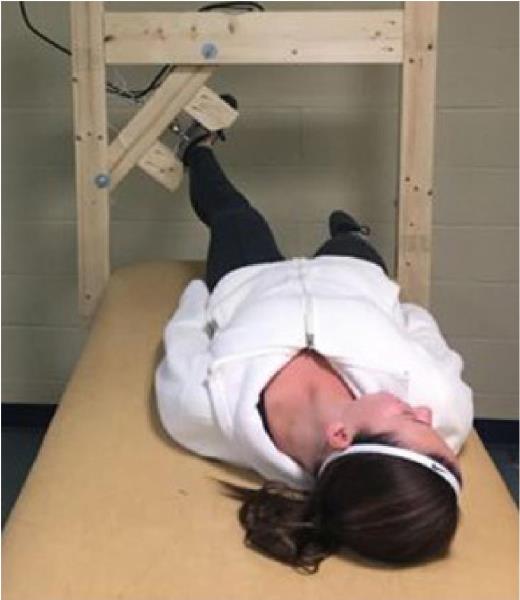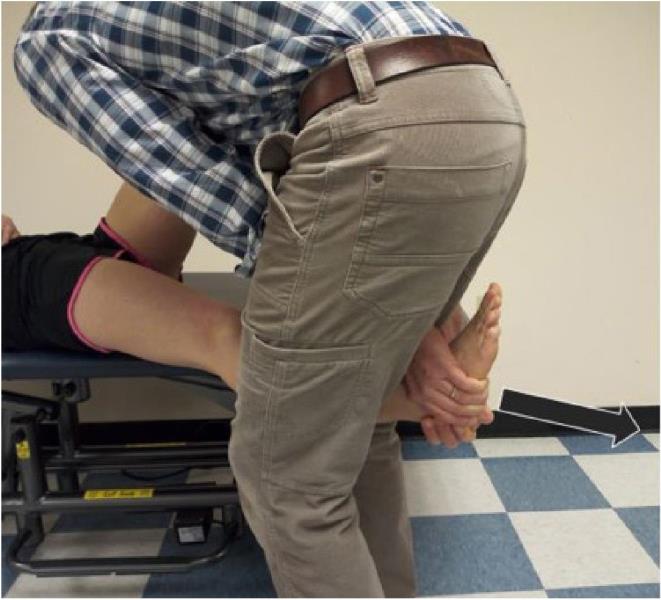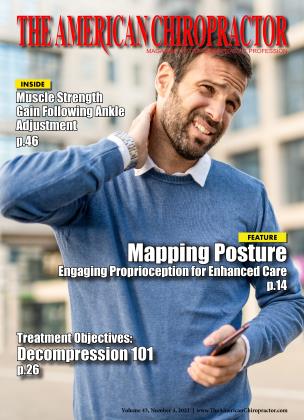A Review of a Recent Study
April 1 2021 Jamie Raymond, DCA Review of a Recent Study
April 1 2021 Jamie Raymond, DCIn middle school we learned the mathematical statement that if A = B and B = C, then A = C. This so-called transitive property helps to explain the logic behind an interesting study recently published in JMPT. In ‘Effects of Tibiofibular and Ankle Joint Manipulation on Hip Strength and Muscle Activation,’ our group was able to show that ankle adjusting had a positive, lasting impact on hip abductor force production and activation in subjects with a prior history of ankle sprain. Before discussing the study we’ll look at some background context.
A = B: Adjusting joint subluxations can positively affect local muscle alterations
In this scenario, we are not talking about the type of weakness that can occur secondary to subluxation-induced nerve root irritation. Rather we’re referring to the local muscular effects that happen when a joint becomes dysfunctional. As Liebler1 states (and most providers intuit), “A joint must have normal mobility in order for its corresponding muscles to work efficiently; evidence has shown that muscle strength and function become altered due to motion restrictions.” This phenomenon is most accurately described as arthrogenic muscle inhibition (AMI). AMI has been described as an ongoing reflex inhibition of the musculature surrounding a joint after distention or damage to the structures of that joint, resulting in altered afferent signals and decreased motorneuron pool excitability.2 AMI results in reduced voluntary muscle activation and ultimately decreases in muscle force output, can relate to but also be independent of pain and swelling of the joint, and may be present long after the acute injury has resolved.3 AMI is thought to be a natural response to protect joints from further damage.2
"...there is a disconnect in the literature that since joint problems cause muscle inhibition, manipulating the affected joints could help."
AMI is a well-established phenomenon in the quads relative to the knee joint, and has also been documented in the gluteus maximus (GMax) secondary to hip joint effusion.4 In the lower extremities, the altered H/M ratios characteristic of AMI have been found in the peroneals5, 6 and soleus5 of patients with functional ankle instability. Similar to how global warming is better described as climate change, AMI produces alterations: while some muscles are inhibited, others can actually have increased activation, or facilitation.3
Freeman et al4 state, “Perhaps this concept of AMI has been accepted as a broad-based neurological truism, due to the fact that patterns of inhibition (and facilitation) have been documented extensively following intra-articular injuries, surgical intervention, and/or fluid administration of some peripheral joints,” and, “has conceptually been generalized to occur at all joints.”
Unfortunately, in the literature at least, treatment for AMI is limited, focused mainly on ice, TENS, and transcranial magnetic stimulation. However, chiropractors regularly employ a modality that has the potential to address at least some types of joint-related AMI: adjusting.
There is a small but growing body of evidence that joint manipulation can help improve local muscle strength and/or activation7 8 9 10. Specific to the ankle, Grindstaff et al10 demonstrated that adjusting at least one of the articulations of the ankle joint complex (AJC)-the distal tibio-fibular- acutely increased soleus muscle activation. (The peroneals were unaffected. However, based on our study’s findings, I suspect they would have seen a change had they also targeted the remaining joints of the complex: talocrural, subtalar, and proximal tibiofibular.)
Although these responses logically and empirically make sense, the evidence is just catching up. To my mind there is a disconnect in the literature that since joint problems cause muscle inhibition, manipulating the affected joints could help. (I think this gap is partially due to the fact that much of the research on AMI involves the quads, and admittedly manipulation is not the treatment of choice for an effused knee.)
B = C: Muscular alterations are also known to occur proximally post ankle injury
Hip abductor weakness after ankle sprain is a fairly well known (and supported11) clinical entity. Additionally, numerous studies have shown changes in gluteal muscle activation after ankle sprain12 or in those with chronic ankle instability (CAI).13,14,15,16 Two studies14,15 that evaluated GMax during functional tasks demonstrated facilitation, one of which supported a centralized ‘feed-forward’ mechanism in CAI patients.14 At least one author suggests that CAI individuals compensate for reduced GMed activity with GMax facilitation.15 (Anatomically this seems logical, as the superior fibers of GMax assist GMed in hip abduction.) I will also add that clinically these patients often exhibit signs of gluteus minimus and/or piriformis compensation, although to my knowledge no one has looked at their activation levels in this context.

A = C: If ankle manipulation helps to address the local muscular alterations that occur after ankle injury, it seems logical that it might also positively affect the proximal alterations known to occur as well.
Our study was designed as a proof of concept, and as such was kept deliberately simple. Twenty-five participants were recruited (mostly DPT students- a perfect population, as they tend to be young and healthy but banged up with old sports injuries.) Included were those with a history of ankle sprain and unilateral hip abductor weakness, as measured with a TFL manual muscle test (MMT). (We chose this over GMed as clinically I initially believed TFL MMT to be more sensitive to AJC dysfunction and less prone to lumbopelvic issues.) Excluded were those who failed a hip flexion MMT, along with anyone with contraindications to ankle manipulation.
Force production was measured before and after a single round of ankle manipulation and again 48 hours later, using a custom-designed rig holding a force transducer along with appropriate blinding. TFL and GMed muscle activation were measured via surface EMG.
Based on motion palpation, I performed HVLA manipulations to all four joints of the AJC on the affected side of each subject, utilizing hand contacts but with the thrust coming from the legs.
(I prefer this adjustment as you can deliver significantly more force with your hamstrings and glutes than with your arms.) We tracked what was adjusted, and while only about half of the proximal and 68% of the distal tib-fib joints required release, 100% of the talocrural and subtalar joints cavitated.

The fact that every subject required release of the talar joints is interesting and something I will elaborate on in Part 2 of this article.
Results: A Does Indeed Equal C
Immediately after manipulation, there was an increase of 12.2% average and 9.8% maximum GMed activation. Forty-eight hours after manipulation average force production increased 18.5% and maximal force production 14.2%. No significant changes were observed in the uninvolved leg. Interestingly these increases are similar in magnitude to Cleland’s study7 measuring lower trap force after thoracic manipulation, and also in line with what we’ve observed thus far in the piloting of our next study, measuring hip muscle response to thoracic manipulation. (If these numbers hold true in future research, perhaps we can legitimately start promoting that manipulation makes you 14%-18% stronger!)
In retrospect it would have been interesting to have also measured GMax activation levels, looking for a potential decrease. Had we been able to show this result it could have spoken to ankle manipulation helping to address a pattern of GMax facilitation accompanying the Gmed inhibition. (Unfortunately, the GMax studies14,15 weren’t yet available when we did our initial literature review, so this measurement didn’t factor into our design. As it was, I purposely thought we should avoid this measurement, as clinically I have observed that even subtle lumbopelvic issues can create GMax inhibition, potentially skewing our results.)
Conclusion
This study was able to demonstrate that HVLA ankle joint manipulation can improve hip abductor muscle function in individuals with a history of ankle sprain, the first time this has been shown. As chiropractors, we are used to thinking of the downstream effects of nerve root irritation. Importantly, however, there are also upstream mechanisms at play that warrant our attention. In sharing our study with others (not just DC’s, but DPT’s and sports allopaths), this proximal effect is what gets keyed in on the most, and is what helped the study garner a Top Five Research Award from the American Academy of Orthopedic Manual Physical Therapists, a nice interdisciplinary kudo.
To be honest I didn’t initiate this study to win awards or because A = C seemed like the next logical step in the literature. I am first and foremost a clinician; I simply hoped to validate a unique treatment aspect that I had already been utilizing for years. Clinically speaking I can tell you that the converse of our findings is also true: by not addressing ankle subluxations you may inadvertently perpetuate hip abductor inhibition, which can factor into a myriad of issues including lower back, hip, and knee conditions.
In Part 2 of this article, we’ll discuss these and other imparts most relevant to a majority of readers: how these findings apply clinically and how MMT and ankle manipulation can help you better treat your patients.
Jamie Raymond, D.C. is a Certified Chiropractic Sports Physician with 20+ years of experience. He specializes in the causes and effects of muscle inhibition as it pertains to musculoskeletal injury, and has developed innovative protocols to help other providers incorporate best practice treatments to tackle their most difficult cases. Check him out on his YouTube channel.
References:
1. Liebler, E & Tufano-Coors, L & Douris, P & Makofsky, H & Mckenna, R & Michels, C & Rattray, S. (2001). The Effect of Thoracic Spine Mobilization On Lower Trapezius Strength Testing. Journal of Manual & Manipulative Therapy. 9. 207-212.
2. Hopkins J, Ingersoll CD, Edwards J, Klootwyk TE. Cryotherapy and Transcutaneous Electric Neuromuscular Stimulation Decrease Arthrogenic Muscle Inhibition of the Vastus Medialis After Knee Joint Effusion. J Athl Train. 2002;37(1):25-31.
3. Sedory EJ, McVey ED, Cross KM, Ingersoll CD, Hertel J. Arthrogenic muscle response of the quadriceps and hamstrings with chronic ankle instability. JAM Train. 2007;42(3):355-360.
4. Freeman S, Mascia A, McGill SM. Arthrogenic neuromusculature inhibition: A foundational investigation of existence in the hip joint. Clinical Biomechanics. 2013;28:171-7.
5. McVey, E & Palmieri-Smith, R & Docherty, C & Zinder, S & Ingersoll, C. Arthrogenic muscle inhibition in the leg muscles of subjects exhibiting functional ankle instability. Foot & ankle international American Orthopaedic Foot and Ankle Society [and] Swiss Foot and Ankle Society. 2005;26: 1055-61.
6. Palmieri-Smith RM, Hopkins JT, Brown TN. Peroneal activation deficits in persons with functional ankle instability. Am J Sports Med. 2009;37(5):982-988.
7. Cleland J, Selleck B, Stowed T, Browne L, Alberini S, Cyr H, Caron T. Short-Term Effects of Thoracic Manipulation on Lower Trapezius Muscle Strength. Journal of Manual & Manipulative Therapy. 2004; 12: 82-90.
8. Grindstaff T, Hertel J, Beazell J, Magrum E, Ingersoll C. Effects of lumbopelvic joint manipulation on quadriceps activation and strength in healthy individuals. Manual Therapy. 2008; 14: 41520.
9. Suter E, McMorland G, Herzog W, Bray R. Conservative lower back treatment reduces inhibition in knee-extensor muscles: a randomized controlled trial. J Manipulative Physiol Ther. 2000 Feb;23(2):76-80.
10. Grindstaff TL, Beazell JR, Sauer LD, Magrum EM, Ingersoll CD, Hertel J. Immediate effects of a tibiofibular joint manipulation on lower extremity H-reflex measurements in individuals with chronic ankle instability. J Electromyogr Kinesiol. 2011 Aug;21(4): 652-8.
11. Friel K, McLean N, Myers C, Caceres M. Ipsilateral hip abductor weakness after inversion ankle sprain. JAM Train. 2006 Jan-Mar;41(l): 74-8.
12. Bullock-Saxton JE, Janda V, Bullock MI. The influence of ankle sprain injury on muscle activation during hip extension. Int J Sports Med. 1994 Aug;15(6):330-4.
13. Koldenhoven RM, Feger MA, Fraser JJ, Saliba S, Hertel J. Surface electromyography and plantar pressure during walking in young adults with chronic ankle instability. Knee Surg Sports Trauma to l A r thro sc. 2016;24(4): 1060-1070.
14. Webster KA, Pietrosimone BG, Gribble PA. Muscle activation during landing before and after fatigue in individuals with or without chronic ankle instability. JAM Train. 2016;51(8):629636.
15. Koldenhoven RM, Fraser JJ, Saliba SA, Hertel J. Ultrasonography of Gluteal and Fibularis Muscles During Exercises in Individuals With a History of Lateral Ankle Sprain. JAM Train. 2019 Dec;54(12):1287-1295.
16. DeJongAF, Koldenhoven RM, Hart JM, Hertel J. Gluteus medius dysfunction in females with chronic ankle instability is consistent at different walking speeds. Clin Biomech (Bristol, Avon). 2020 Mar; 73:140-148.
 View Full Issue
View Full Issue






